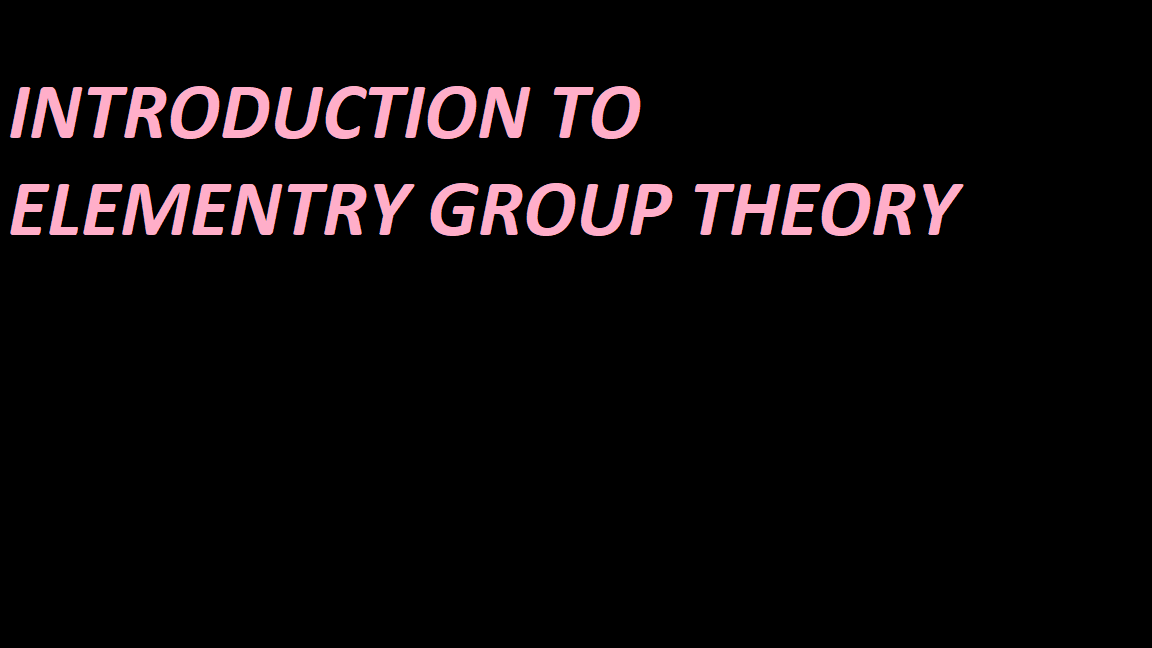Introduction to elementary group theory
Introduction:Group theory is the study of algebraic structures called groups. This theory will rely heavily on set theory and modular arithmetic as well . It will require an understanding o...

Algebraic Structure
A set together with a binary operation gives rise to what is known as an algebraic structure.
Given a, b, c as the elements of the set G, the algebraic structure (G,*) maybe:
Closed
Commutative
Associative
Existing of Identity element
Existing of inverse element
Group
The non- empty set G together with the binary operation ౦ is said to be a group if it satisfies the following axioms/ properties:
Closure Axiom:
For elements a, b ∈ G, a ౦ b ∈ G
Associative Axiom:
For a, b, c ∈ G, (a ౦ b) ౦ c = a ౦ (b ౦ c)
Existence of Identity Element:
For a ∈ G, there exists an identity element e ∈ G, such that, a ౦ e = e ౦ a = a
Existence of Inverse Element:
For each element a ∈ G, there exists an inverse element a-1 ∈ G, such that, a ౦ a-1 = a-1 ౦ a = e
Exercise:
Prove that G= {1, ω, ω2}, where ω is a cube root of unity, is a group under multiplication.
Solution:
The cayley’s table is as follows:
Note that: ω3=1
i) Closure Axiom It is clear from the table above that all the elements of the table belong to G. So, the closure axiom is satisfied.
ii) Associative Axiom
∵ 1, ω, ω2 ∈ G
∴ (1 х ω) х ω2 = 1 х (ω х ω2)
or, ω х ω2 = 1 х ω3
or, 1=1 (True)
Similarly, the axiom is true for other elements too. So, associativity is satisfied.
iii) Existence of Identity element
Here, 1 is the identity element as 1 fixes all other elements and also 1 ∈ G. So, the existence of identity is satisfied.
iv) Existence of inverse element
Here, 1 х 1 = 1. So, 1 is the inverse of 1
ω х ω2 = ω2 х ω = 1. So, ω is the inverse of ω2 and vice versa.
All three elements lie within G.
So, the existence of an inverse element is also satisfied.
Hence, all the properties of a group are satisfied. So, G is a group.
Finite and Infinite Group
A group is finite if it has a finite number of elements and a group is called infinite if it has infinite number of elements.
The set S= {1, -1} is a finite group under multiplication and its order is 2.
The set of integers is an infinite group under addition.
Trivial Group
A group consisting of only one element is a trivial group.
The set G= {0} ωith addition is a trivial group.
Abelian Group
The group G is said to be an abelian group if it satisfies commutative axiom,
i.e. for all a, b ∈ G, a ౦ b = b ౦ a
Exercise 2: Show that the set of all (+)ve rational numbers form an abelian group under composition defined by a ౦ b = 
Solution:
Let Q+ = set of (+)ve rational numbers
Q+ = {1, 2, 3, ……,  }
}
1) Closure Property:
For a, b ∈ Q+
a ౦ b =  ∈ Q+ as the product and division of (+)ve rational numbers is always a (+)ve rational number.
∈ Q+ as the product and division of (+)ve rational numbers is always a (+)ve rational number.
So, the closure property is satisfied.
2) Associative Property
Let a, b, c ∈ Q+
Then, (a ౦ b) ౦ c = a ౦ (b ౦ c)
 ౦ c = a ౦
౦ c = a ౦ 
∴abc= abc (True)
So, the associative property is also satisfied.
3) Commutative property
Let a, b ∈ Q+
a ౦ b = b ౦ a
 =
=
∴ab= ab (True)
So, the commutative property is also satisfied.
3) Existence of Identity Element
Let e be the identity element
Then, a ౦ e = a
or,  = a
= a
or, e = 4 ∈ Q+
And this identity element also lies in Q+.
So, the existence of the identity element is satisfied.
4) Existence of Inverse Element
Let a ∈ Q+ and a-1 be the inverse of a
Then, a ౦ a-1 = e
or,  = 4
= 4
or, a-1 =  ∈ Q+
∈ Q+
So, the existence of an inverse element is also satisfied.
Hence, Q+ is an abelian group.